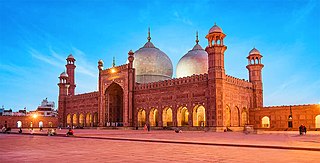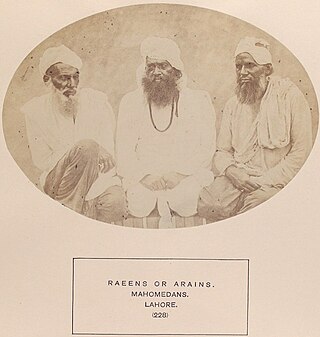Central Punjab | |
|---|---|
| Country | |
| Province | |
| Demonym | Central Punjabi |
| Time zone | PKT (UTC+05:00) |
Central Punjab is a geopolitical region in Punjab, Pakistan. [1]
Central Punjab | |
|---|---|
| Country | |
| Province | |
| Demonym | Central Punjabi |
| Time zone | PKT (UTC+05:00) |
Central Punjab is a geopolitical region in Punjab, Pakistan. [1]
Central Punjab is bounded by the southern boundary of Jhelum River down to the Sutlej, and consists of the five divisions: Lahore, Gujrat, Gujranwala, Faisalabad, and Sahiwal as well as two districts, Vehari and Sargodha. It comprises a third of land area of Punjab and 58% of its population, and produced Punjab's 45% of wheat, 69% of corn, and 83% of rice during 2019–2020. [2] [3] Central Punjab and Pothohar Plateau collectively comprise "Upper Punjab". [4]

Punjab, also known as the Land of the Five Rivers, is a geopolitical, cultural, and historical region in South Asia. It is located in the northwestern part of the Indian subcontinent, comprising areas of modern-day eastern-Pakistan and northwestern-India. Punjab's major cities are Lahore, Faisalabad, Rawalpindi, Gujranwala, Multan, Ludhiana, Amritsar, Sialkot, Chandigarh, Shimla, Jalandhar, Patiala, Gurugram, and Bahawalpur.

Punjab is a province of Pakistan. With a population of over 127 million, it is the most populous province in Pakistan and second most populous subnational polity in the world. Located in the central-eastern region of the country, it has the largest economy, contributing the most to national GDP, in Pakistan. Lahore is the capital and largest city. Other major cities include Faisalabad, Rawalpindi, Gujranwala and Multan.

Lahore is the capital and largest city of the Pakistani province of Punjab. It is the second largest city in Pakistan, after Karachi, and 26th largest in the world, with a population of over 13 million. Located in central-eastern Punjab, along the River Ravi, it is the largest Punjabi-speaking city in the world. Lahore is one of Pakistan's major industrial, educational and economic hubs. It has been the historic capital and cultural centre of the wider Punjab region, and is one of Pakistan's most socially liberal, progressive, and cosmopolitan cities.

Bahawalpur is a city in Punjab, Pakistan. It is the 13th largest city of Pakistan and 8th most populous city of Punjab. Bahawalpur is the capital of Bahawalpur Division.

Bahawalpur was a princely state in subsidiary alliance with British Raj and later Dominion of Pakistan, that was a part of the Punjab States Agency. The state covered an area of 45,911 km2 (17,726 sq mi) and had a population of 1,341,209 in 1941. The capital of the state was the town of Bahawalpur.

Gujrat is the thirteenth largest city in the Pakistani province of Punjab. Located on the western bank of the Chenab River in northern Punjab's Chaj Do'āb, it serves as the headquarters of the eponymous district and disvision; and is the 20th most populous in Pakistan, with a population of 390,533 in 2017. Along with Sialkot and Gujranwala, Gujrat forms part of the "Golden Triangle of Punjab", as these industrial cities have export-oriented economies.

Sialkot is a city located in Punjab, Pakistan. It is the capital of the Sialkot District and the 12th most populous city in Pakistan. The boundaries of Sialkot are joined by Jammu in the north east, the districts of Narowal in the southeast, Gujranwala in the southwest and Gujrat in the northwest. Sialkot is known as the city of Allama Iqbal.

Multan is a city in Punjab, Pakistan, located on the bank of river Chenab. It is one of the five largest urban centres of Pakistan in 2024 and is the administrative centre of Multan Division. It is a major cultural, religious and economic centre of Punjab region, Multan is one of the oldest cities of Asia with a history stretching deep into antiquity.

The University of the Punjab (UoP), also referred to as the Punjab University (PU), is a public research university in Lahore, Punjab, Pakistan. Founded in 1882, its international influence has made it one of the most prestigious universities in South Asia; being the oldest and largest public sector one in the wider Punjab region, as well as in Pakistan.

The Kamboj, also Kamboh, is a caste and cultivating community of India and Pakistan that originated from the central Punjab region.

Arain are a large Punjabi Muslim agricultural community with a strong political identity and level of organisation.

Mian Iftikharuddin was a Pakistani politician, activist of the Indian National Congress, who later joined the All-India Muslim League and worked for the cause of Pakistan under the leadership of Muhammad Ali Jinnah. He was known for his left-wing politics and briefly served as the Provincial Minister for Rehabiilitation of Refugees in Punjab.

Dai Anga Mosque is a mosque situated to southeast of the Lahore Railway Station, in the city of Lahore in Pakistan's Punjab province. The mosque is said to have been built in 1635 in honour of the wetnurse of the Mughal Emperor Shah Jahan, Dai Anga.
Awan is a tribe and surname centred in the Northern Pakistan and Punjab region of Pakistan. Awans are predominantly present in the northern, central, and western parts of Punjab, with significant population also present in Khyber Pakhtunkhwa, Azad Kashmir, and to a lesser extent, in Sindh and Balochistan. The tribe claim Arab, particularly Alid, origin through its primary ancestor Qutub Shah, who came to modern-day Pakistan with Mahmud of Ghazni.
Kharal is a Punjabi Muslim tribe predominantly found in the Sandal Bar region of Punjab and some parts of Sindh.
Begum Jahanara Shahnawaz, also known as Jehan Ara Shah Nawaz, was a prominent activist and politician in Punjab, active before and after independence of Pakistan. She was educated at Queen Mary College, Lahore. A dedicated member of the All India Muslim League, she was also a leading advocate for women's rights. She was the daughter of Sir Muhammad Shafi and the wife of Mian Muhammad Shahnawaz.
Lahnda, also known as Lahndi or Western Punjabi, is a group of north-western Indo-Aryan language varieties spoken in parts of Pakistan and India. It is defined in the ISO 639 standard as a "macrolanguage" or as a "series of dialects" by other authors. Its validity as a genetic grouping is not certain. The terms "Lahnda" and "Western Punjabi" are exonyms employed by linguists, and are not used by the speakers themselves.

The Pothohar Plateau, also spelled Pothwar, is a plateau in the northern region of Punjab, Pakistan, located between the Indus and Jhelum rivers.
Punjabi Muslims are Punjabis who are adherents of Islam. With a population of more than 112 million, they are the third-largest predominantly Islam-adhering Muslim ethnicity in the world, after Arabs and Bengalis.

Pir Syed Jamaat Ali Shah was a Pakistani author, Islamic scholar and Sufi saint of the Naqshbandi Order. He presided over the All India Sunni Conference and led the Movement for Shaheed Ganj Mosque. He was a contemporary of Ahmed Raza Khan Barelvi, the founder of Barelvi movement.